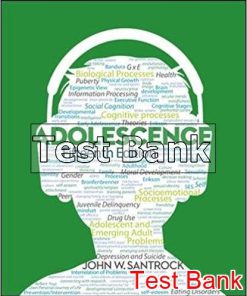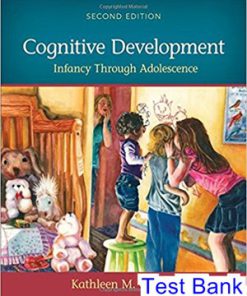A Child’s World Infancy Through Adolescence 13th Edition Martorell Test Bank
$26.50$50.00 (-47%)
Childs World Infancy Through Adolescence 13th Edition Martorell Test Bank.
You may also like
-
$26.50
$50.00 -
$26.50
$50.00 -
$26.50
$50.00
A Child’s World Infancy Through Adolescence 13th Edition Martorell Test Bank

Product details:
- ISBN-10 : 0078035430
- ISBN-13 : 978-0078035432
- Author: Gabriela Martorell, Diane Papalia, Ruth Feldman
Martorell, Papalia, and Feldman continue to provide the extensive cross-cultural and multicultural coverage, innovative pedagogical learning system, and balance between research and real-life applications that has made A Child’s World a favorite of students and professors alike.
Table contents:
- Preface
- Chapter 1 Studying a Child’s World
- The Study of Child Development: Then and Now
- Early Approaches
- Developmental Psychology Becomes a Science
- Studying the Life Span
- New Frontiers
- The Study of Child Development: Basic Concepts
- Domains of Development
- Periods of Development
- Influences on Development
- Heredity, Environment, and Maturation
- Contexts of Development
- 1.1 Around the World Children of Immigrant Families
- Normative and Nonnormative Influences
- 1.2 The Everyday World Studying the Life Course: Growing Up in Hard Times
- Timing of Influences: Critical or Sensitive Periods
- An Emerging Consensus
- 1.3 The Research World Is There a Critical Period for Language Acquisition?
- summary and key terms
- Chapter 2 A Child’s World: How We Discover It
- Basic Theoretical Issues
- Issue 1: Is Development Active or Reactive?
- Issue 2: Is Development Continuous or Discontinuous?
- Theoretical Perspectives
- Perspective 1: Psychoanalytic
- Perspective 2: Learning
- Perspective 3: Cognitive
- Perspective 4: Contextual
- Perspective 5: Evolutionary/Sociobiological
- A Shifting Balance
- 2.1 The Research World The Adaptive Value of Immaturity
- Research Methods
- Quantitative and Qualitative Research
- Sampling
- Forms of Data Collection
- Evaluating Quantitative and Qualitative Research
- Basic Research Designs
- 2.2 Around the World Purposes of Cross-Cultural Research
- Developmental Research Designs
- Collaborative Research
- Ethics of Research
- Right to Informed Consent
- Avoidance of Deception
- Right to Self-Esteem
- Right to Privacy and Confidentiality
- summary and key terms
- Chapter 3 Forming a New Life: Conception, Heredity, and Environment
- Conceiving a New Life
- Changing Theories of Conception
- How Fertilization Takes Place
- Infertility
- Causes of Infertility
- Treatments for Infertility
- Alternative Ways to Parenthood: Assisted Reproductive Technology
- 3.1 The Everyday World Multiple Births
- Mechanisms of Heredity
- The Genetic Code
- What Determines Sex?
- Patterns of Genetic Transmission
- Genetic and Chromosomal Abnormalities
- Dominant or Recessive Inheritance of Defects
- Sex-Linked Inheritance of Defects
- Chromosomal Abnormalities
- Genetic Counseling and Testing
- Nature and Nurture: Influences of Heredity and Environment
- 3.2 The Research World Genetic Testing
- Studying the Relative Influences of Heredity and Environment
- How Heredity and Environment Work Together
- Some Characteristics Influenced by Heredity and Environment
- Physical and Physiological Traits
- Intelligence
- Personality
- Psychopathology
- summary and key terms
- Chapter 4 Pregnancy and Prenatal Development
- Prenatal Development: Three Stages
- The Germinal Stage (Fertilization to 2 Weeks)
- The Embryonic Stage (2 to 8 Weeks)
- 4.1 Around the World Mourning a Miscarriage or Stillbirth
- The Fetal Stage (8 Weeks to Birth)
- Prenatal Development: Environmental Influences
- Maternal Factors
- 4.2 The Everyday World Fetal Welfare versus Mothers’ Rights
- Paternal Factors
- Monitoring and Promoting Prenatal Development
- Disparities in Prenatal Care
- The Need for Preconception Care
- summary and key terms
- Chapter 5 Birth and the Newborn Baby
- Childbirth and Culture: How Birthing Has Changed
- Reducing the Risks of Childbirth
- Contemporary Settings for Childbirth
- The Birth Process
- Stages of Childbirth
- Electronic Fetal Monitoring
- Vaginal versus Cesarean Delivery
- Medicated versus Nonmedicated Delivery
- The Newborn Baby
- Size and Appearance
- 5.1 Around the World Having a Baby in the Himalayas
- Body Systems
- Medical and Behavioral Assessment
- States of Arousal and Activity Levels
- Complications of Childbirth—and Their Aftermath
- Low Birth Weight
- 5.2 The Everyday World Comforting a Crying Baby
- Postmaturity
- Stillbirth
- Can a Supportive Environment Overcome Effects of Birth Complications?
- Newborns and Parents
- Infant Care: A Cross-Cultural View
- Childbirth and Bonding
- What Do Newborns Need from Their Mothers?
- The Father’s Role
- How Parenthood Affects Marital Satisfaction
- summary and key terms
- Chapter 6 Physical Development and Health during the First Three Years
- Early Growth and Physical Development
- Principles of Early Growth and Physical Development
- Growth Patterns
- Nutrition and Feeding Methods
- Breast or Bottle?
- Starting Solid Foods
- Is Being Overweight a Problem in Infancy?
- The Brain and Reflex Behavior
- Building the Brain
- 6.1 The Research World The Autism “Epidemic”
- Early Reflexes
- Molding the Brain: The Role of Experience
- Early Sensory Capacities
- Touch and Pain
- Smell and Taste
- Hearing
- Sight
- Motor Development
- Milestones of Motor Development
- Motor Development and Perception
- Eleanor and James Gibson’s Ecological Theory of Perception
- How Motor Development Occurs: Thelen’s Dynamic Systems Theory
- Cultural Influences on Motor Development
- Health
- Reducing Infant Mortality
- 6.2 Around the World Sleep Customs
- Immunization for Better Health
- Maltreatment: Abuse and Neglect
- Maltreatment in Infancy and Toddlerhood
- Contributing Factors: An Ecological View
- Helping Families in Trouble
- Long-Term Effects of Maltreatment
- summary and key terms
- Chapter 7 Cognitive Development during the First Three Years
- Studying Cognitive Development: Six Approaches
- Behaviorist Approach: Basic Mechanics of Learning
- Classical and Operant Conditioning
- Infant Memory
- Psychometric Approach: Developmental and Intelligence Testing
- Testing Infants and Toddlers
- Assessing the Impact of the Home Environment
- Early Intervention
- Piagetian Approach: The Sensorimotor Stage
- Substages of the Sensorimotor Stage
- Do Imitative Abilities Develop Earlier than Piaget Thought?
- Development of Knowledge about Objects and Space
- Evaluating Piaget’s Sensorimotor Stage
- Information-Processing Approach: Perceptions and Representations
- Habituation
- Visual and Auditory Processing Abilities
- Information Processing as a Predictor of Intelligence
- 7.1 The Everyday World Do Infants and Toddlers Watch Too Much Television?
- Information Processing and the Development of Piagetian Abilities
- Evaluating Information-Processing Research on Infants
- Cognitive Neuroscience Approach: The Brain’s Cognitive Structures
- Social-Contextual Approach: Learning from Interactions with Caregivers
- Language Development
- Sequence of Early Language Development
- Characteristics of Early Speech
- Classic Theories of Language Acquisition: The Nature-Nurture Debate
- 7.2 Around the World Inventing Sign Language
- Influences on Language Development
- Preparing for Literacy: The Benefits of Reading Aloud
- summary and key terms
- Chapter 8 Psychosocial Development during the First Three Years
- Foundations of Psychosocial Development
- Emotions
- Temperament
- Developmental Issues in Infancy
- Developing Trust
- Developing Attachments
- Emotional Communication with Caregivers: Mutual Regulation
- 8.1 The Everyday World How Postpartum Depression Affects Early Development
- Developmental Issues in Toddlerhood
- The Emerging Sense of Self
- Developing Autonomy
- 8.2 Around the World Are Struggles with Toddlers Necessary?
- The Roots of Moral Development: Socialization and Internalization
- Gender: How Different Are Baby Boys and Girls?
- Gender Differences in Infants and Toddlers
- How Parents Shape Gender Differences
- Contact with Other Children
- Siblings
- Sociability with Nonsiblings
- Children of Working Parents
- Effects of Maternal Employment
- Early Child Care
- summary and key terms
- Chapter 9 Physical Development and Health in Early Childhood
- Aspects of Physiological Development
- Bodily Growth and Change
- Sleep Patterns and Problems
- Sleep Disturbances and Disorders
- Bed-Wetting
- Brain Development
- Motor Development
- Gross and Fine Motor Skills
- Handedness
- Artistic Development
- Health and Safety
- Nutrition: Preventing Obesity
- 9.1 Around the World Surviving the First Five Years of Life
- Undernutrition
- 9.2 The Everyday World Food Security
- Food Allergies
- Oral Health
- Accidental Injuries and Deaths
- Health in Context: Environmental Influences
- summary and key terms
- Chapter 10 Cognitive Development in Early Childhood
- Piagetian Approach: The Preoperational Child
- Advances of Preoperational Thought
- Immature Aspects of Preoperational Thought
- Do Young Children Have Theories of Mind?
- 10.1 The Everyday World Imaginary Companions
- Information-Processing Approach: Memory Development
- Basic Processes and Capacities
- Recognition and Recall
- Forming and Retaining Childhood Memories
- Intelligence: Psychometric and Vygotskian Approaches
- Traditional Psychometric Measures
- Influences on Measured Intelligence
- Testing and Teaching Based on Vygotsky’s Theory
- Language Development
- Vocabulary
- Grammar and Syntax
- Pragmatics and Social Speech
- Delayed Language Development
- Preparation for Literacy
- 10.2 The Research World Private Speech: Piaget versus Vygotsky
- Media and Cognition
- Early Childhood Education
- Types of Preschools
- Compensatory Preschool Programs
- The School of the Twenty-First Century: Universal Preschool
- The Child in Kindergarten
- summary and key terms
- Chapter 11 Psychosocial Development in Early Childhood
- The Developing Self
- The Self-Concept and Cognitive Development
- Self-Esteem
- Understanding and Regulating Emotions
- Erikson: Initiative versus Guilt
- Gender
- Gender Differences
- Perspectives on Gender Development
- Play: The Business of Early Childhood
- Cognitive Levels of Play
- 11.1 The Research World Does Play Have an Evolutionary Basis?
- The Social Dimension of Play
- How Gender Influences Play
- How Culture Influences Play
- Parenting
- Forms of Discipline
- 11.2 The Everyday World The Case against Corporal Punishment
- Parenting Styles
- Special Behavioral Concerns
- Prosocial Behavior
- Aggression
- Fearfulness
- Relationships with Other Children
- Sibling Relationships
- The Only Child
- Playmates and Friends
- summary and key terms
- Chapter 12 Physical Development and Health in Middle Childhood
- Aspects of Physical Development
- Height and Weight
- Tooth Development and Dental Care
- Brain Development
- Nutrition and Sleep
- Nutritional Needs
- Sleep Patterns and Problems
- Motor Development and Physical Play
- Recess-Time Play
- Organized Sports
- Health and Safety
- Overweight and Body Image
- 12.1 The Everyday World Do Barbie Dolls Affect Girls’ Body Image?
- Medical Conditions
- Factors in Health and Access to Health Care
- Accidental Injuries
- 12.2 Around the World How Cultural Attitudes Affect Health Care
- Mental Health
- Common Emotional Disturbances
- Treatment Techniques
- summary and key terms
- Chapter 13 Cognitive Development in Middle Childhood
- Piagetian Approach: The Concrete Operational Child
- Cognitive Advances
- Influences of Neurological Development and Schooling
- Moral Reasoning
- Information-Processing Approach: Attention, Memory, and Planning
- How Do Executive Skills Develop?
- Selective Attention
- Working Memory
- Metamemory: Understanding Memory
- Mnemonics: Strategies for Remembering
- Information Processing and Piagetian Tasks
- Psychometric Approach: Assessment of Intelligence
- The IQ Controversy
- Influences on Intelligence
- Is There More than One Intelligence?
- Other Directions in Intelligence Testing
- Language and Literacy
- Vocabulary, Grammar, and Syntax
- Pragmatics: Knowledge about Communication
- Second-Language Learning
- Literacy
- The Child in School
- Entering First Grade
- Influences on School Achievement
- 13.1 The Research World The Homework Debate
- 13.2 The Everyday World The Math Wars
- Educating Children with Special Needs
- Children with Learning Problems
- Gifted Children
- summary and key terms
- Chapter 14 Psychosocial Development in Middle Childhood
- The Developing Self
- Self-Concept Development: Representational Systems
- Industry versus Inferiority
- Emotional Growth and Prosocial Behavior
- The Child in the Family
- Family Atmosphere
- 14.1 The Research World Pass the Milk: Family Mealtimes and Child Well-Being
- Family Structure
- Sibling Relationships
- The Child in the Peer Group
- Positive and Negative Effects of Peer Relations
- Gender Differences in Peer-Group Relationships
- Popularity
- Friendship
- Aggression and Bullying
- Stress and Resilience
- Stresses of Modern Life
- Coping with Stress: The Resilient Child
- 14.2 The Everyday World Talking with Children about Terrorism and War
- summary and key terms
- Chapter 15 Physical Development and Health in Adolescence
- Adolescence: A Developmental Transition
- Adolescence as a Social Construction
- 15.1 Around the World The Globalization of Adolescence
- Adolescence: A Time of Opportunities and Risks
- Puberty: The End of Childhood
- How Puberty Begins: Hormonal Changes
- Timing, Signs, and Sequence of Puberty and Sexual Maturity
- Implications of Early and Late Maturation
- The Adolescent Brain
- Physical and Mental Health
- Physical Activity
- Sleep Needs and Problems
- Nutrition and Eating Disorders
- Use and Abuse of Drugs
- Depression
- Death in Adolescence
- Protective Factors: Health in Context
- summary and key terms
- Chapter 16 Cognitive Development in Adolescence
- Aspects of Cognitive Maturation
- Piaget’s Stage of Formal Operations
- Elkind: Immature Characteristics of Adolescent Thought
- Language Development
- Changes in Information Processing in Adolescence
- Moral Development
- Kohlberg’s Theory of Moral Reasoning
- 16.1 The Research World Fowler’s Stages of Faith
- Gilligan’s Theory: An Ethic of Care
- Prosocial Behavior and Volunteer Activity
- Educational and Vocational Issues
- Influences on School Achievement
- 16.2 The Everyday World Multitasking and Gen M
- Dropping Out of High School
- Preparing for Higher Education or Vocations
- summary and key terms
- Chapter 17 Psychosocial Development in Adolescence
- The Search for Identity
- Erikson: Identity versus Identity Confusion
- Marcia: Identity Status—Crisis and Commitment
- Gender Differences in Identity Formation
- Ethnic Factors in Identity Formation
- Sexuality
- Sexual Orientation and Identity
- Sexual Behavior
- Sexually Transmitted Infections (STIs)
- Teenage Pregnancy and Childbearing
- 17.1 Around the World Preventing Teenage Pregnancy
- Relationships with Family and Peers
- Is Adolescent Rebellion a Myth?
- Changing Time Use and Changing Relationships
- Adolescents and Parents
- Adolescents and Siblings
- Peers and Friends
- Antisocial Behavior and Juvenile Delinquency
- 17.2 The Everyday World The Youth Violence Epidemic
- Becoming a Delinquent: Genetic and Neurological Factors
- Becoming a Delinquent: How Family, Peer, and Community Influences Interact
- Long-Term Prospects
- Preventing and Treating Delinquency
- Emerging Adulthood
- summary and key terms
- Glossary
- Bibliography
- Credits
- Name Index
- Subject Index
People also search:
A Child’s World Infancy Through Adolescence 13th Edition
A Child’s World Infancy Through Adolescence 13th
A Child’s World Infancy Through Adolescence 13th ed pdf
A Child’s World Infancy Through Adolescence 13th pdf
A Child’s World Infancy Through Adolescence












